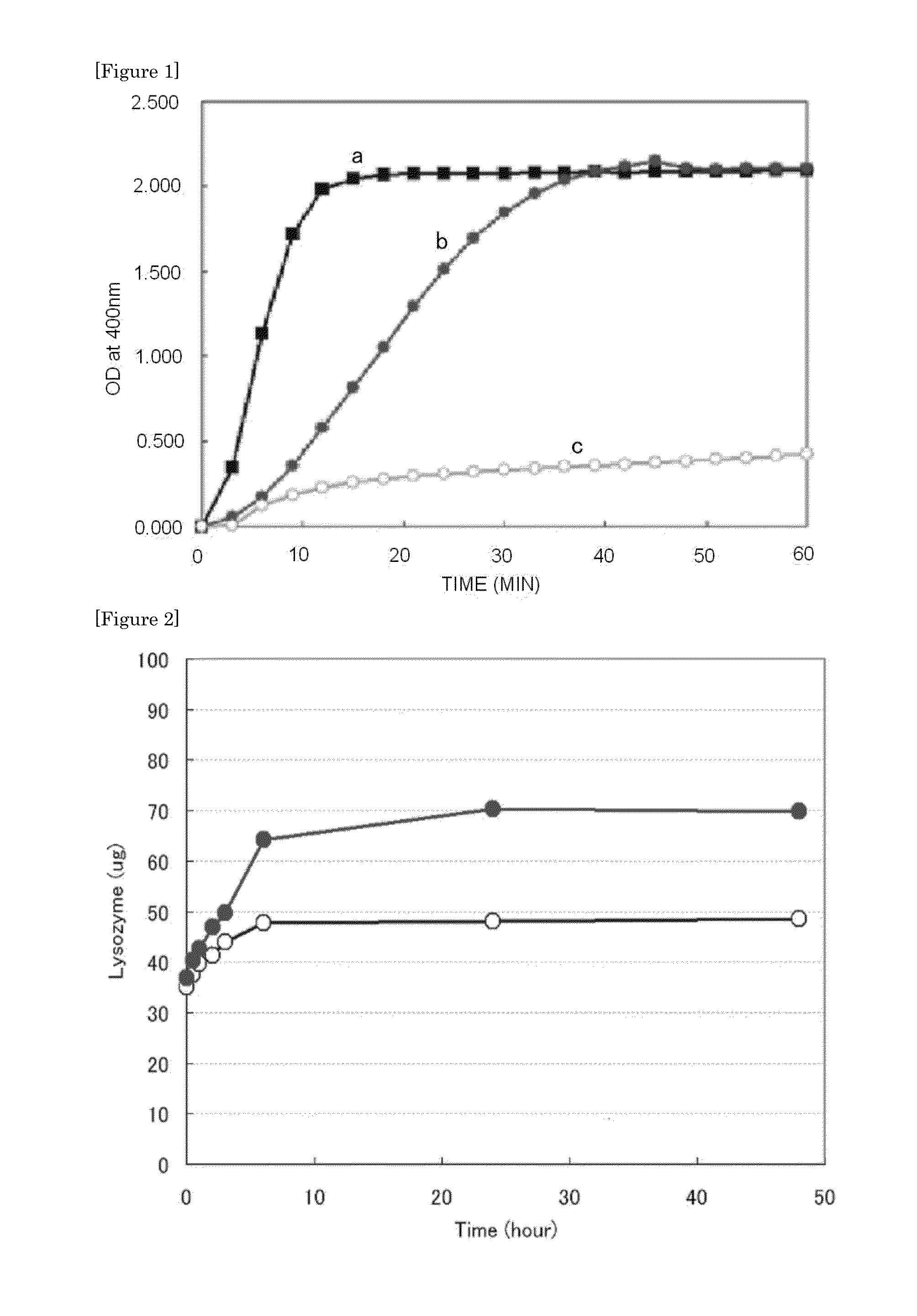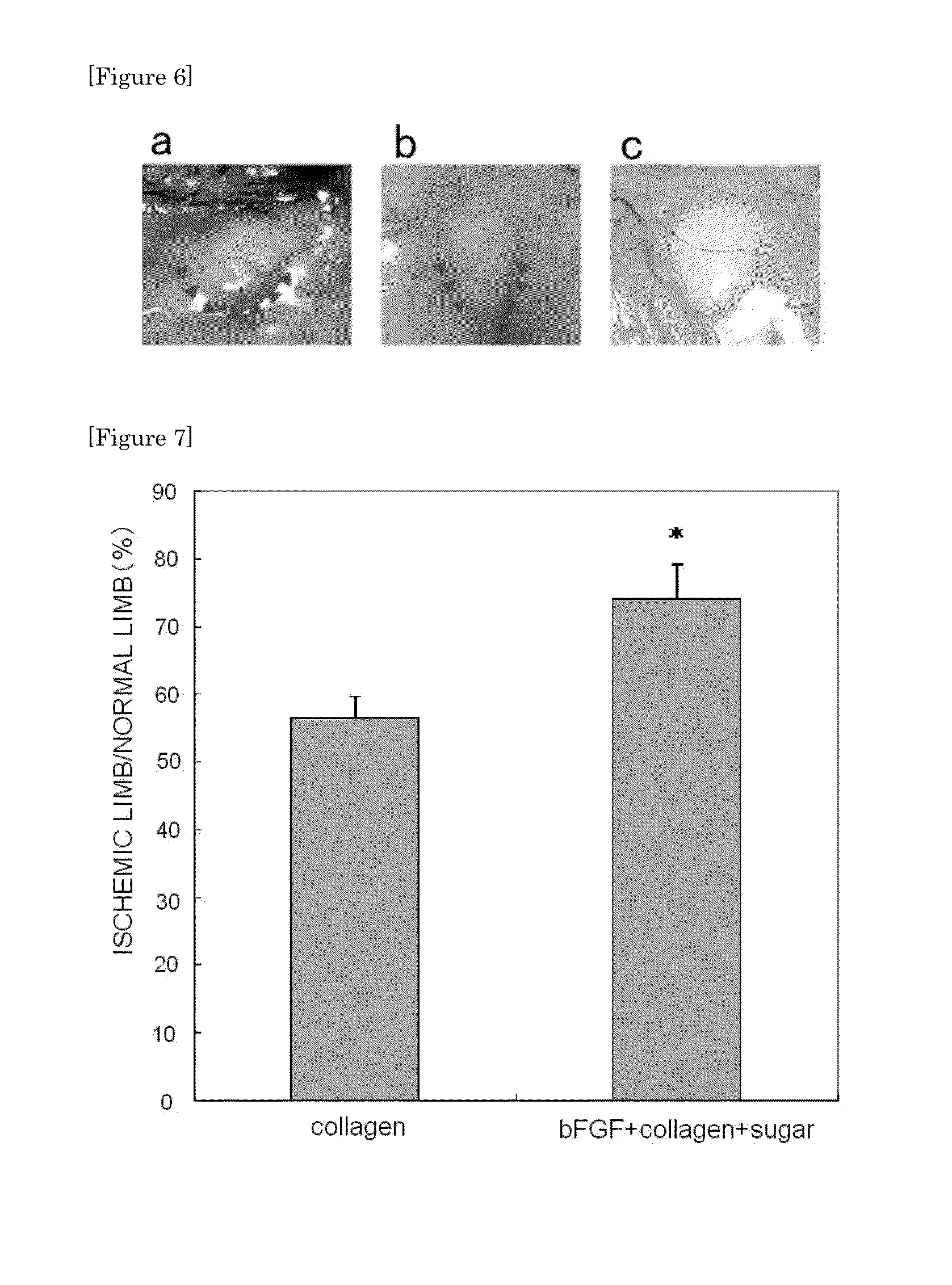Sustained-Release Pharmaceutical Composition
a pharmaceutical composition and sustained release technology, applied in the direction of drug compositions, peptides, peptides/protein ingredients, etc., can solve the problems of insufficient drug efficacy, lack of convenience in formulation, and need for sophisticated technology, so as to reduce the release rate of drugs and facilitate the preparation operation. , the effect of slow sustained releas
- Summary
- Abstract
- Description
- Claims
- Application Information
AI Technical Summary
Benefits of technology
Problems solved by technology
Method used
Image
Examples
reference example 1
Spectroscopic Evaluation of Influence of Sugar on Gelation Ability of Collagen Solution
[0089]Specifically, a sucrose solution was added to a collagen solution (pH 7.4, final concentration: 3% [w / v]) (product name: KOKEN ATELOCOLLAGEN IMPLANT) so that the final concentration was 0, 0.01, or 0.25 M, followed by mixing. The mixed solution was measured for its time-dependent change in absorbance at 400 nm with a spectrophotometer while being heated at 37° C.
[0090]FIG. 1 shows the results. In the figure, “a” shows the result in the case of a collagen only, “b” shows the result in the case of a blend of a collagen and 0.01 M sucrose, and “c” shows the result in the case of a blend of a collagen and 0.25 M sucrose. The collagen solution to which no sucrose was added underwent gelation in about 10 minutes. In each of the collagen solutions to which sucrose was added, its gelation was delayed in a sucrose concentration-dependent manner.
example 1
Confirmation of Influence of Sugar on Drug Release from Collagen
[0091]The influence of a sugar on drug release from a collagen was confirmed through use of lysozyme (final concentration: 2 mg / mL) (Sigma-Aldrich Corporation) as a drug.
[0092]Lysozyme was dissolved in a physiological buffer (PBS, pH 7.4) containing sucrose (final concentration: 0.05 M) or a physiological buffer containing no sucrose. After that, the solution and an atelocollagen solution (final concentration: 3% [w / v]) (product name: KOKEN ATELOCOLLAGEN IMPLANT) were mixed and formulated. The resultant formulation was gently added to a solution containing PBS as an external liquid in a test tube, followed by heating at 37° C., and the amount of the lysozyme released into the external liquid in a time-dependent manner was measured by HPLC (system integrator: C-R7A [Shimadzu Corporation], system controller: SCL-6B [Shimadzu Corporation], pump: LC-9A [Shimadzu Corporation], degasser: ERC-3522 [Elma], detector: SPC-6AV [Sh...
example 2
Confirmation of Influence of Formulation Procedure on In Vivo Gelation of Collagen
[0100]The following three kinds of ingredients were mixed in different orders and formulated as shown in the following items a) to c): lysozyme (MW: 14 kDa) (final concentration: 2 mg / mL); sucrose (final concentration: 0.25 M); and atelocollagen (final concentration: 3% [w / v]) (product name: KOKEN ATELOCOLLAGEN IMPLANT).
a) (P+S)+AC formulation: First, Lysozyme and sucrose were mixed, and next atelocollagen was added to prepare a formulation.
b) (P+AC)+S formulation: First, lysozyme and atelocollagen were mixed, and next sucrose was added to prepare a formulation.
c) (S+AC)+P formulation: First, sucrose and atelocollagen were mixed, and next lysozyme was added to prepare a formulation.
[0101]An AC formulation formed only of atelocollagen was used as a control formulation.
[0102]100 μL of each of the formulations according to the above-mentioned items a) to c) were administered to the dorsal subcutis of mice...
PUM
| Property | Measurement | Unit |
|---|---|---|
| molecular weight | aaaaa | aaaaa |
| time | aaaaa | aaaaa |
| time | aaaaa | aaaaa |
Abstract
Description
Claims
Application Information
 Login to View More
Login to View More - R&D
- Intellectual Property
- Life Sciences
- Materials
- Tech Scout
- Unparalleled Data Quality
- Higher Quality Content
- 60% Fewer Hallucinations
Browse by: Latest US Patents, China's latest patents, Technical Efficacy Thesaurus, Application Domain, Technology Topic, Popular Technical Reports.
© 2025 PatSnap. All rights reserved.Legal|Privacy policy|Modern Slavery Act Transparency Statement|Sitemap|About US| Contact US: help@patsnap.com



